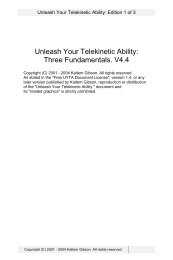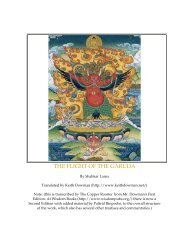Hiller - The Myth of Primitivism. Perspectives on Art - Esoteric Online
Hiller - The Myth of Primitivism. Perspectives on Art - Esoteric Online
Hiller - The Myth of Primitivism. Perspectives on Art - Esoteric Online
You also want an ePaper? Increase the reach of your titles
YUMPU automatically turns print PDFs into web optimized ePapers that Google loves.
<str<strong>on</strong>g>The</str<strong>on</strong>g> myth <str<strong>on</strong>g>of</str<strong>on</strong>g> primitivism 266<br />
suggesting an easy soluti<strong>on</strong> to the more mundane but nevertheless pressing problem <str<strong>on</strong>g>of</str<strong>on</strong>g><br />
finding a uniquely Australian c<strong>on</strong>tent to our art in an internati<strong>on</strong>al climate sympathetic to<br />
the noti<strong>on</strong> <str<strong>on</strong>g>of</str<strong>on</strong>g> ‘regi<strong>on</strong>al’ art. <str<strong>on</strong>g>The</str<strong>on</strong>g> reality <str<strong>on</strong>g>of</str<strong>on</strong>g> ‘cultural c<strong>on</strong>vergence’ which necessitates that<br />
political and ec<strong>on</strong>omic inequities be rectified first is a less satisfying prospect. Certainly<br />
‘aboriginality’ is not a new idea—the Antipodeans in the 1950s and the Jindyworobak<br />
poets in the 1940s as well as others before them like Margaret Prest<strong>on</strong> (who suggested it<br />
should form the basis <str<strong>on</strong>g>of</str<strong>on</strong>g> a ‘modern’ Australian art) were attracted to it—the difference<br />
today is that c<strong>on</strong>temporary art forms and media particularly in the areas <str<strong>on</strong>g>of</str<strong>on</strong>g> informal<br />
sculpture and performance can approximate more closely the ‘look’ <str<strong>on</strong>g>of</str<strong>on</strong>g> traditi<strong>on</strong>al<br />
Aboriginal artefacts, rituals, and envir<strong>on</strong>ments.<br />
<str<strong>on</strong>g>The</str<strong>on</strong>g> ‘c<strong>on</strong>cerned c<strong>on</strong>science’ about the Aboriginal people which ‘aboriginality’ might<br />
reflect, however, does not <str<strong>on</strong>g>of</str<strong>on</strong>g>ten originate am<strong>on</strong>g the Australian-born. Interest in<br />
Aboriginal culture has and c<strong>on</strong>tinues to come mostly from abroad. 8 (<str<strong>on</strong>g>The</str<strong>on</strong>g>y do not have to<br />
share our guilt.) Thus during the Sydney biennale European Dialogue, 1979, Australian<br />
artists were <str<strong>on</strong>g>of</str<strong>on</strong>g>ten dismayed by the interest in and knowledge <str<strong>on</strong>g>of</str<strong>on</strong>g> Aboriginal culture shown<br />
by visiting artists and critics and the almost aggressive indifference they displayed to the<br />
Australian urban envir<strong>on</strong>ment and its culture. Some, like Marina Abramovic and Ulay<br />
even returned later (under a Visual <strong>Art</strong>s Board grant) to seek out (with typically<br />
Germanic zeal and determinati<strong>on</strong>) the Aboriginal influence for their own work. <str<strong>on</strong>g>The</str<strong>on</strong>g>ir stay<br />
culminated in an ‘alchemical’ performance at the <strong>Art</strong> Gallery <str<strong>on</strong>g>of</str<strong>on</strong>g> New South Wales: Gold<br />
Found by the <strong>Art</strong>ists. This work (dealing with their ‘survival experience, percepti<strong>on</strong><br />
changes, energy and telepathy’) 9 together with the attitudes subsequently expressed about<br />
Aborigines, 10 stands as a c<strong>on</strong>spicuous model <str<strong>on</strong>g>of</str<strong>on</strong>g> a more ‘serious’, more earnest<br />
‘aboriginality’ for local artists. Since ‘advanced’ art in the twentieth century habitually<br />
aspires to the c<strong>on</strong>diti<strong>on</strong> <str<strong>on</strong>g>of</str<strong>on</strong>g> religi<strong>on</strong>, it is little w<strong>on</strong>der that the spiritual resource <str<strong>on</strong>g>of</str<strong>on</strong>g><br />
Aboriginal culture and its esoteric practices should now be recognized and associati<strong>on</strong><br />
with it c<strong>on</strong>sciously sought.<br />
Suzi Gablik, in an article for <strong>Art</strong> in America, ‘Report from Australia’, emphasized the<br />
links to the c<strong>on</strong>tinent’s Aboriginal past in certain c<strong>on</strong>temporary work. She speaks <str<strong>on</strong>g>of</str<strong>on</strong>g><br />
Australian artists being less embroiled in repressive cultural heritages than their<br />
American or European counterparts and thus able to look sympathetically to nature and<br />
even ‘able to trace, in a clear, quiet way, some old paths back to the aboriginal<br />
presence’. 11 Such optimistic remarks (as exhortati<strong>on</strong>s to acti<strong>on</strong>) clearly reflect the change<br />
in critical attitudes towards ‘regi<strong>on</strong>alism’, a word which now has ascendancy over the<br />
formerly popular and derogatory expressi<strong>on</strong> ‘provincialism’. For today we believe that<br />
‘remarkable work is as likely to arise in Cracow, Turin, Düsseldorf, Vienna, Paris,<br />
L<strong>on</strong>d<strong>on</strong> or Amsterdam as in New York’. 12 Why not Sydney or Melbourne as well? <str<strong>on</strong>g>The</str<strong>on</strong>g><br />
old Jindyworobak noti<strong>on</strong> <str<strong>on</strong>g>of</str<strong>on</strong>g> envir<strong>on</strong>mental value—the ‘slow moulding <str<strong>on</strong>g>of</str<strong>on</strong>g> all people<br />
within a c<strong>on</strong>tinent or regi<strong>on</strong> towards the human form which that c<strong>on</strong>tinent demands’ 13<br />
seems ready for a revival and ‘aboriginality’ is being <str<strong>on</strong>g>of</str<strong>on</strong>g>fered again as an appropriate<br />
form.<br />
This widespread though largely unstated hope (or even belief) in an ‘indigenous’<br />
Australian art ignores the c<strong>on</strong>temporary understanding <str<strong>on</strong>g>of</str<strong>on</strong>g> the nature <str<strong>on</strong>g>of</str<strong>on</strong>g> the physical<br />
world. Just as the discovery <str<strong>on</strong>g>of</str<strong>on</strong>g> the special theory <str<strong>on</strong>g>of</str<strong>on</strong>g> relativity and quantum mechanics<br />
revoluti<strong>on</strong>ized our view <str<strong>on</strong>g>of</str<strong>on</strong>g> the world in the first quarter <str<strong>on</strong>g>of</str<strong>on</strong>g> the twentieth century, so Bell’s




